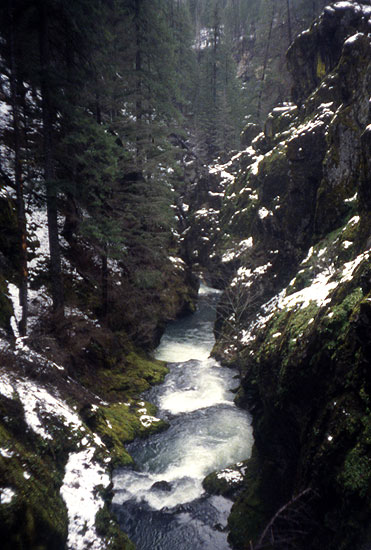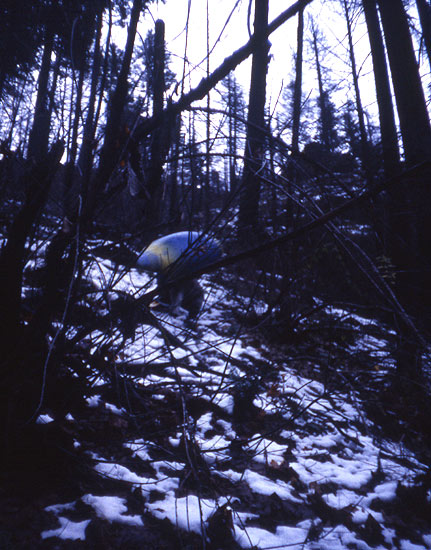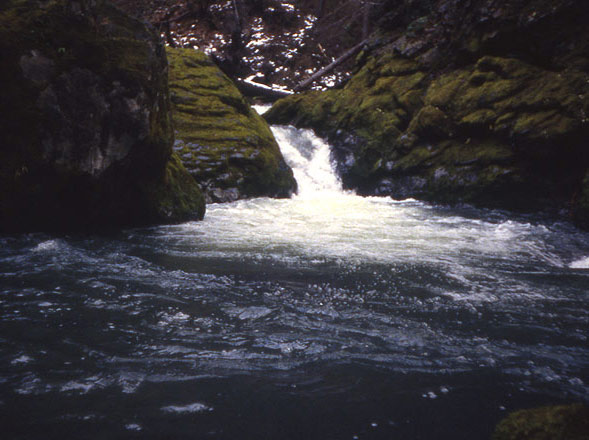
By Steve Stuckmeyer
Although I have heard of a few pioneers running Boulder Creek, I could find no information on it. Nevertheless, I suspected that although it would not be a first descent, it might be a second (or third), especially since the only way to access the run was a 3-mile hike that gains 900 feet in elevation. At one point I hiked in and after the 900 foot climb (in one mile) I found a beautiful plateau covered with old-growth cedars, firs, and meadows of lush grasses. My few glimpses over the canyon rim gave evidence to a creek tumbling over boulders; it looked like a very special place. It intrigued me greatly, and I knew I had to run it.

Two and a half years passed, during which I had a number of adventures, and I finally decided I had waited long enough. I started pushing hard to find companions for the descent of Boulder Creek, but my normally adventurous group of paddling buddies all seemed to have other things to do. Only one, John Whaley, was interested. Of course this didn't surprise me at all, since John has been known to climb 8,000 foot mountains just to get to an unexplored creek. We had high hopes when we loaded our gear and headed south to the Umpqua basin; it was just after Thanksgiving and we had recently had rain on some early snow, so we were pretty certain there would be plenty of water.
On the drive up the North Umpqua we started to see patches of snow at about 1500 feet. Unfortunately it seemed the snowfall had been so heavy in this part of the state that the rain had not been enough to melt it all. This didn't seem to be that great of an omen. When we got to our camp on the banks of the North Umpqua, and just upstream of the confluence with Boulder Creek, we found it to be quite cold with large patches of snow.
John and I tried to wake early the next morning, but the cold made both of us tardy. We ended up striking camp and heading up the trail at about 10am. We were fairly confident that this gave us enough time to make the three mile run; we should be at the creek by noon and have 5 hours of daylight for boating back out. I made good time on the way up the mountainside, but John was lagging a bit; the difference was caused by my carrying my Topolino on a backpack frame, and John shouldering his 60 pound behemoth of a Perception Stikine. I waited when I reached the plateau, and soon John was leading me; this time due to the difference between breaking trail through six inch deep snow with tennis shoes versus paddling shoes.
We did reach the put-in by noon, but were pretty worried by that point. What had once been massive old growth forest had been swept by fire and was more of a graveyard of charred snags. Most of the dead trees, and many of the live ones, were falling since the scorched soil had become too unstable to afford them adequate purchase. This was not a good sign. We were praying that the fire had spared the inner canyon, but the logs in the creek just below our launch point were another bad sign.
We were able to dodge the first few logs, and then we rounded a corner to confront a 12 foot waterfall. I had seen this on a previous reconnaissance. Immediately below the waterfall we had to portage a logjam and then made some dicey moves around another. Then we rounded a corner, the canyon walls closed in, and the creek disappeared with a low rumble.

Unfortunately without excessive commitment, and climbing equipment, we could not descend the 100 foot walls into this place. So we began an epic portage that lasted about a quarter of a mile. Initially we had to climb up at least 100 vertical feet in order to be able to make a traverse safely away from the sheer inner walls of the gorge, even then the scree slopes were precarious; after a bad slip, the resulting fall could probably be arrested, but a boat would have tumbled hundreds of feet into the waiting gorge. Eventually we reached a point where it was safe to descend to the creek, but even then it required four separate belays using John's 70 foot throw rope; meanwhile all our gear was turning black from the soot that ringed every tree or snag. The scout and portage had eaten up about 2 hours of daylight.

We reentered the creek just below the gorge and boated a few hundred yards of class IV whitewater that had been turned trashy by too low water, and more importantly by the forest fire. Then we entered the nightmare where the whitewater turned to class V, remained somewhat trashy, and small trees had fallen across the creek every 100 yards or so. This pretty much meant everything became one long mandatory portage. Usually the log blockages were in sufficiently continuous and complex rapids, that they rendered a long stretch unrunnable (or at least very, very unsafe). I was able to run more with my Topolino that John was with his Stikine, so I was often out front and waiting. It was obvious to both of us that we were screwed. There was no way we were going to get off the creek before nightfall. Finally with one hour of daylight left and the canyon walls above us starting to box out, we had to make our decision.
John was contemplating just admitting defeat and carrying his boat back out; I was pretty opposed to this option. I felt just as defeated, but having drug my boat up 600 vertical feet out of the La Grande Canyon on the Nisqually, I had absolutely no desire to repeat the experience. I wanted to go downstream at all costs. Eventually we came to the conclusion that we'd leave the boats, and make the decision the next morning whether to hike back in with the intent of bringing them up and out, or going downstream. We made the climb up out of the canyon and started hiking back to our camp. We decided we had only made about 1 mile in just under four hours of boating! It was pitch black about 30 minutes before we reached the camp, and I wasn't sure I ever wanted to go back in after my boat.
The next day was just as brutal as the first. It took us about six hours to boat two more miles; much of the time we were portaging long stretches. At one point I fell off a snow-covered log and dropped about five feet onto my leg, head, and knee; I saw a lot of stars, and I think I almost broke my femur on that one, and you can figure out what would have happened if I had. I had one particularly scary close encounter with a log sieve when I ran one section that John was portaging, and came dangerously close to swimming when I ran a narrow slot that was backed up by a very mean hole (John scouted that one, and ended up portaging after seeing the havoc that the line he pointed out wreaked on me).

I must say that Boulder Creek was quite an adventure, and it could have been a classic class V whitewater run, but it has been destroyed by that forest fire. It is unlikely that it will be anything but a nightmare for many, many years to come.